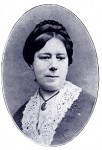 Translating hymns is no small feat. This is what I’ve concluded after making a first attempt at translating German poetry. Besides conveying the sense of the text, you have to put into metrical form, ideally preserving the meter and rhyme of the original, and do it in a way that sounds good.
Translating hymns is no small feat. This is what I’ve concluded after making a first attempt at translating German poetry. Besides conveying the sense of the text, you have to put into metrical form, ideally preserving the meter and rhyme of the original, and do it in a way that sounds good.
So I’ve really come to appreciate the work of Catherine Winkworth (1827-1878). She was a prolific translator of German chorales, including “Praise to the Lord, the Almighty” and “Now thank we all our God.” The accounts of her life that I’ve found so far are all rather brief, but all state unequivocally that she did more than anyone to bring the German chorale tradition to English-speaking churches, and that her translations are the most widely used of any from the German.
She was an educated woman who, in addition to her translation work, advocated for higher education for women. My guess is that her family was pretty well connected, since, according to one account, it was the German ambassador to England who introduced her to German hymnody. She published her first collection of hymn translations, Lyra Germanica Series 1, in 1854 or ’55, when she was still in her twenties. She followed with Series 2 in 1858.
In her introduction to her third collection, The Chorale Book for England (1863), Winkworth writes about the challenges of translating the German texts. She wanted to present the texts with their “proper” tunes, that is, the tunes with which they are commonly associated. That meant preserving the meter of the original texts. She explains:
This has necessitated the frequent use of the double rhymes, which the structure of the German language renders as common, and indeed inevitable, in German as monosyllabic rhymes are with us. The comparatively small number of the former in our language present a serious obstacle to rendering the German hymns into English with the force and simplicity they possess in their own tongue, and without which they cannot become truly naturalized among us; yet it is one which must be encountered if the tunes also are to be introduced with them, as they ought to be, and in their proper form.
For instance, in “Praise to the Lord, the Almighty,” three of the five lines in each stanza have a double rhyme, in which the second-last syllable is stressed and the last is not. Stanza 1 in German rhymes Ehren, Begehren, and hören in stanza 1; Winkworth uses creation, salvation and adoration.
She didn’t just deal with the obstacles of translation; she did so while producing English versions that are graceful and singable. A great gift to the English-speaking church.